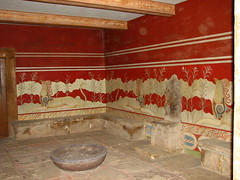The artwork of the earliest civilized peoples of Greece, the tribes of the Aegean, is beautiful and unique. I can describe vases, statues, architecture and other creations of the era c. 1600 BC and the pinnacle of Cretan influence in the Mediterranean as breahtaking, but Mikhail Rostovtzeff can actually convey this sense with the elegance of his description:
M. Rostovtzeff Greece p.28-29:
Aegean art, so live and sparkling, is all full of humanity and individuality; it is free from the oppressive magnificence and majesty of the god-king, before whom his subjects are pitiable grains of desert sand before the sun; it bubbles like a fountain with vivacity and merriment; it thirsts for life and delights in life; it is intoxicated with sea and sun, trees and flowers, sport and war. These men reproduce life on their household utensils, on the walls of their houses, and in works of art; their fancy is not for separate figures or portraits---no portraits have been bequeathed to us by them---but for groups; and these groups are not rows of identical figures but related to one another and full of movement. The ornament is lively, impersonal, capricious, and infinitely various, finding models everywhere, both in the elegance of the geometric spiral and in natural objects, such as flowers and marine animals, and the odder these are, the better---cuttle-fish, flying fish, sea-shells.
This why the productions of Aegean art, sometimes sketchy and impressionistic, often childish in their simplicity, impress us so strongly after the splendid monuments of the East---the refinement of Egypt and the dramatic power of Babylon...But Aegean art carries us beyond the limits of the palace, and shows us other lively pictures; bulls caught with nets in the forest; the attack on a fortress by enemies who come from the sea; the ship carrying a statue of a horse (it recalls the horse of Troy); a funeral procession and rites performed at the grave. Their is not a trace of conventionality or tradition throughout, and there is hardly any repetition. The brightness and variety of the colours is surprising; their arer laid, one on another or one beside another, in the most unexpected combinations, with a constant endeavour to get novel tints.
Moreover, this allows me the excuse to post this picture of gryphons. Our favorite mythical beasts adorn the the throne room at Knossos c. 1450 BC.
Photo used under a Creative Commons license from user Winninator.


1 comment:
The[re] is not a trace of conventionality or tradition throughout, and there is hardly any repetition.
Unfortunately, untrue. Aegean art is just as conventional and traditional and repetitive as any other ancient art. True, it looks different and appears (to our eyes) more naturalistic. That simply means that it's closer to our artistic conventions.
However, I agree one needs very little excuse for posting pix of griffins. I put a winged, horned lion (a close relative) on my blog recently. :-)
Post a Comment